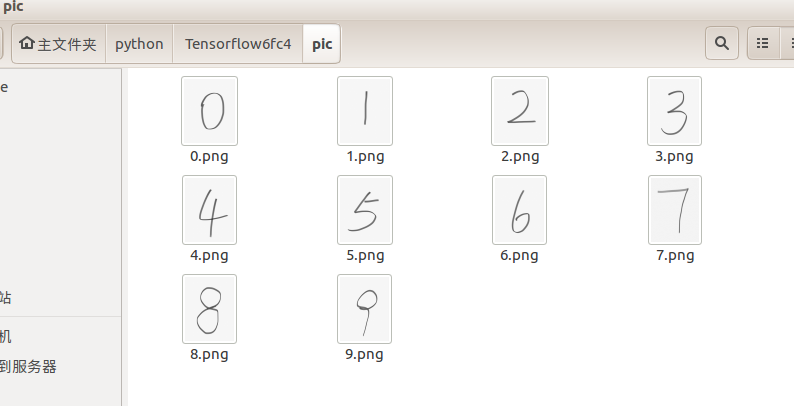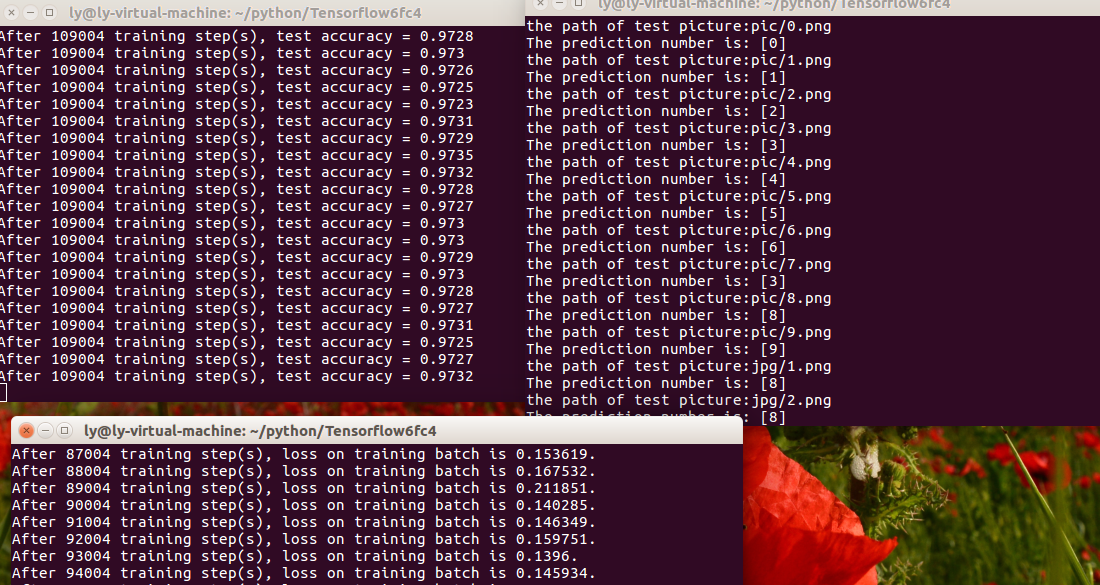数据集地址:

测试集地址:

代码如下:
forward.py
#coding:utf-8 #1前向传播过程 import tensorflow as tf #网络输入节点为784个(代表每张输入图片的像素个数) INPUT_NODE = 784 #输出节点为10个(表示输出为数字0-9的十分类) OUTPUT_NODE = 10 #隐藏层节点500个 LAYER1_NODE = 500 def get_weight(shape, regularizer): #参数满足截断正态分布,并使用正则化, w = tf.Variable(tf.truncated_normal(shape,stddev=0.1)) #w = tf.Variable(tf.random_normal(shape,stddev=0.1)) #将每个参数的正则化损失加到总损失中 if regularizer != None: tf.add_to_collection('losses', tf.contrib.layers.l2_regularizer(regularizer)(w)) return w def get_bias(shape): #初始化的一维数组,初始化值为全 0 b = tf.Variable(tf.zeros(shape)) return b def forward(x, regularizer): #由输入层到隐藏层的参数w1形状为[784,500] w1 = get_weight([INPUT_NODE, LAYER1_NODE], regularizer) #由输入层到隐藏的偏置b1形状为长度500的一维数组, b1 = get_bias([LAYER1_NODE]) #前向传播结构第一层为输入 x与参数 w1矩阵相乘加上偏置 b1 ,再经过relu函数 ,得到隐藏层输出 y1。 y1 = tf.nn.relu(tf.matmul(x, w1) + b1) #由隐藏层到输出层的参数w2形状为[500,10] w2 = get_weight([LAYER1_NODE, OUTPUT_NODE], regularizer) #由隐藏层到输出的偏置b2形状为长度10的一维数组 b2 = get_bias([OUTPUT_NODE]) #前向传播结构第二层为隐藏输出 y1与参 数 w2 矩阵相乘加上偏置 矩阵相乘加上偏置 b2,得到输出 y。 #由于输出 。由于输出 y要经过softmax oftmax 函数,使其符合概率分布,故输出y不经过 relu函数 y = tf.matmul(y1, w2) + b2 return y
mnist_backward.py
#coding:utf-8 import tensorflow as tf from tensorflow.examples.tutorials.mnist import input_data import mnist_forward import os import mnist_generateds#1 BATCH_SIZE = 200 LEARNING_RATE_BASE = 0.1 LEARNING_RATE_DECAY = 0.99 REGULARIZER = 0.0001 STEPS = 50000 MOVING_AVERAGE_DECAY = 0.99 MODEL_SAVE_PATH="./model/" MODEL_NAME="mnist_model" #手动给出训练的总样本数6万 train_num_examples = 60000#2 def backward(): x = tf.placeholder(tf.float32, [None, mnist_forward.INPUT_NODE]) y_ = tf.placeholder(tf.float32, [None, mnist_forward.OUTPUT_NODE]) y = mnist_forward.forward(x, REGULARIZER) global_step = tf.Variable(0, trainable=False) ce = tf.nn.sparse_softmax_cross_entropy_with_logits(logits=y, labels=tf.argmax(y_, 1)) cem = tf.reduce_mean(ce) loss = cem + tf.add_n(tf.get_collection('losses')) learning_rate = tf.train.exponential_decay( LEARNING_RATE_BASE, global_step, train_num_examples / BATCH_SIZE, LEARNING_RATE_DECAY, staircase=True) train_step = tf.train.GradientDescentOptimizer(learning_rate).minimize(loss, global_step=global_step) ema = tf.train.ExponentialMovingAverage(MOVING_AVERAGE_DECAY, global_step) ema_op = ema.apply(tf.trainable_variables()) with tf.control_dependencies([train_step, ema_op]): train_op = tf.no_op(name='train') saver = tf.train.Saver() #一次批获取 batch_size张图片和标签 img_batch, label_batch = mnist_generateds.get_tfrecord(BATCH_SIZE, isTrain=True)#3 with tf.Session() as sess: init_op = tf.global_variables_initializer() sess.run(init_op) ckpt = tf.train.get_checkpoint_state(MODEL_SAVE_PATH) if ckpt and ckpt.model_checkpoint_path: saver.restore(sess, ckpt.model_checkpoint_path) #利用多线程提高图片和标签的批获取效率 coord = tf.train.Coordinator()#4 #启动输入队列的线程 threads = tf.train.start_queue_runners(sess=sess, coord=coord)#5 for i in range(STEPS): #执行图片和标签的批获取 xs, ys = sess.run([img_batch, label_batch])#6 _, loss_value, step = sess.run([train_op, loss, global_step], feed_dict={x: xs, y_: ys}) if i % 1000 == 0: print("After %d training step(s), loss on training batch is %g." % (step, loss_value)) saver.save(sess, os.path.join(MODEL_SAVE_PATH, MODEL_NAME), global_step=global_step) #关闭线程协调器 coord.request_stop()#7 coord.join(threads)#8 def main(): backward()#9 if __name__ == '__main__': main()
mnist_generateds.py
#coding:utf-8 import tensorflow as tf import numpy as np from PIL import Image import os image_train_path='./data/mnist_data_jpg/mnist_train_jpg_60000/' label_train_path='./data/mnist_data_jpg/mnist_train_jpg_60000.txt' tfRecord_train='./data/mnist_train.tfrecords' image_test_path='./data/mnist_data_jpg/mnist_test_jpg_10000/' label_test_path='./data/mnist_data_jpg/mnist_test_jpg_10000.txt' tfRecord_test='./data/mnist_test.tfrecords' data_path='./data' resize_height = 28 resize_width = 28 #生成tfrecords文件 def write_tfRecord(tfRecordName, image_path, label_path): #新建一个writer writer = tf.python_io.TFRecordWriter(tfRecordName) num_pic = 0 f = open(label_path, 'r') contents = f.readlines() f.close() #循环遍历每张图和标签 for content in contents: value = content.split() img_path = image_path + value[0] img = Image.open(img_path) img_raw = img.tobytes() labels = [0] * 10 labels[int(value[1])] = 1 #把每张图片和标签封装到example中 example = tf.train.Example(features=tf.train.Features(feature={ 'img_raw': tf.train.Feature(bytes_list=tf.train.BytesList(value=[img_raw])), 'label': tf.train.Feature(int64_list=tf.train.Int64List(value=labels)) })) #把example进行序列化 writer.write(example.SerializeToString()) num_pic += 1 print ("the number of picture:", num_pic) #关闭writer writer.close() print("write tfrecord successful") def generate_tfRecord(): isExists = os.path.exists(data_path) if not isExists: os.makedirs(data_path) print 'The directory was created successfully' else: print 'directory already exists' write_tfRecord(tfRecord_train, image_train_path, label_train_path) write_tfRecord(tfRecord_test, image_test_path, label_test_path) #解析tfrecords文件 def read_tfRecord(tfRecord_path): #该函数会生成一个先入先出的队列,文件阅读器会使用它来读取数据 filename_queue = tf.train.string_input_producer([tfRecord_path], shuffle=True) #新建一个reader reader = tf.TFRecordReader() #把读出的每个样本保存在serialized_example中进行解序列化,标签和图片的键名应该和制作tfrecords的键名相同,其中标签给出几分类。 _, serialized_example = reader.read(filename_queue) #将tf.train.Example协议内存块(protocol buffer)解析为张量 features = tf.parse_single_example(serialized_example, features={ 'label': tf.FixedLenFeature([10], tf.int64), 'img_raw': tf.FixedLenFeature([], tf.string) }) #将img_raw字符串转换为8位无符号整型 img = tf.decode_raw(features['img_raw'], tf.uint8) #将形状变为一行784列 img.set_shape([784]) img = tf.cast(img, tf.float32) * (1. / 255) #变成0到1之间的浮点数 label = tf.cast(features['label'], tf.float32) #返回图片和标签 return img, label def get_tfrecord(num, isTrain=True): if isTrain: tfRecord_path = tfRecord_train else: tfRecord_path = tfRecord_test img, label = read_tfRecord(tfRecord_path) #随机读取一个batch的数据 img_batch, label_batch = tf.train.shuffle_batch([img, label], batch_size = num, num_threads = 2, capacity = 1000, min_after_dequeue = 700) #返回的图片和标签为随机抽取的batch_size组 return img_batch, label_batch def main(): generate_tfRecord() if __name__ == '__main__': main()
test.py
#coding:utf-8 import time import tensorflow as tf from tensorflow.examples.tutorials.mnist import input_data import mnist_forward import mnist_backward import mnist_generateds TEST_INTERVAL_SECS = 5 #手动给出测试的总样本数1万 TEST_NUM = 10000#1 def test(): with tf.Graph().as_default() as g: x = tf.placeholder(tf.float32, [None, mnist_forward.INPUT_NODE]) y_ = tf.placeholder(tf.float32, [None, mnist_forward.OUTPUT_NODE]) y = mnist_forward.forward(x, None) ema = tf.train.ExponentialMovingAverage(mnist_backward.MOVING_AVERAGE_DECAY) ema_restore = ema.variables_to_restore() saver = tf.train.Saver(ema_restore) correct_prediction = tf.equal(tf.argmax(y, 1), tf.argmax(y_, 1)) accuracy = tf.reduce_mean(tf.cast(correct_prediction, tf.float32)) #用函数get_tfrecord替换读取所有测试集1万张图片 img_batch, label_batch = mnist_generateds.get_tfrecord(TEST_NUM, isTrain=False)#2 while True: with tf.Session() as sess: ckpt = tf.train.get_checkpoint_state(mnist_backward.MODEL_SAVE_PATH) if ckpt and ckpt.model_checkpoint_path: saver.restore(sess, ckpt.model_checkpoint_path) global_step = ckpt.model_checkpoint_path.split('/')[-1].split('-')[-1] #利用多线程提高图片和标签的批获取效率 coord = tf.train.Coordinator()#3 #启动输入队列的线程 threads = tf.train.start_queue_runners(sess=sess, coord=coord)#4 #执行图片和标签的批获取 xs, ys = sess.run([img_batch, label_batch])#5 accuracy_score = sess.run(accuracy, feed_dict={x: xs, y_: ys}) print("After %s training step(s), test accuracy = %g" % (global_step, accuracy_score)) #关闭线程协调器 coord.request_stop()#6 coord.join(threads)#7 else: print('No checkpoint file found') return time.sleep(TEST_INTERVAL_SECS) def main(): test()#8 if __name__ == '__main__': main()
mnist_app.py
#coding:utf-8 import tensorflow as tf import numpy as np from PIL import Image import mnist_backward import mnist_forward def restore_model(testPicArr): #利用tf.Graph()复现之前定义的计算图 with tf.Graph().as_default() as tg: x = tf.placeholder(tf.float32, [None, mnist_forward.INPUT_NODE]) #调用mnist_forward文件中的前向传播过程forword()函数 y = mnist_forward.forward(x, None) #得到概率最大的预测值 preValue = tf.argmax(y, 1) #实例化具有滑动平均的saver对象 variable_averages = tf.train.ExponentialMovingAverage(mnist_backward.MOVING_AVERAGE_DECAY) variables_to_restore = variable_averages.variables_to_restore() saver = tf.train.Saver(variables_to_restore) with tf.Session() as sess: #通过ckpt获取最新保存的模型 ckpt = tf.train.get_checkpoint_state(mnist_backward.MODEL_SAVE_PATH) if ckpt and ckpt.model_checkpoint_path: saver.restore(sess, ckpt.model_checkpoint_path) preValue = sess.run(preValue, feed_dict={x:testPicArr}) return preValue else: print("No checkpoint file found") return -1 #预处理,包括resize,转变灰度图,二值化 def pre_pic(picName): img = Image.open(picName) reIm = img.resize((28,28), Image.ANTIALIAS) im_arr = np.array(reIm.convert('L')) #对图片做二值化处理(这样以滤掉噪声,另外调试中可适当调节阈值) threshold = 50 #模型的要求是黑底白字,但输入的图是白底黑字,所以需要对每个像素点的值改为255减去原值以得到互补的反色。 for i in range(28): for j in range(28): im_arr[i][j] = 255 - im_arr[i][j] if (im_arr[i][j] < threshold): im_arr[i][j] = 0 else: im_arr[i][j] = 255 #把图片形状拉成1行784列,并把值变为浮点型(因为要求像素点是0-1 之间的浮点数) nm_arr = im_arr.reshape([1, 784]) nm_arr = nm_arr.astype(np.float32) #接着让现有的RGB图从0-255之间的数变为0-1之间的浮点数 img_ready = np.multiply(nm_arr, 1.0/255.0) return img_ready def application(): #输入要识别的几张图片 testNum = input("input the number of test pictures:") for i in range(testNum): #给出待识别图片的路径和名称 testPic = raw_input("the path of test picture:") #图片预处理 testPicArr = pre_pic(testPic) #获取预测结果 preValue = restore_model(testPicArr) print "The prediction number is:", preValue def main(): application() if __name__ == '__main__': main()
在视频中mnist_generateds.py中,加上.data的路径;如果不加会报错;

结果:


会发现对于视频中老师的数据集预测结果准确率高,但自己手写的出错率却很低。
下一篇博文主要讲解一下理解自定义数据集的步骤和代码;
注:本文章通过观看北京大学曹健老师的Tensorflow视频,笔记总结而来的。